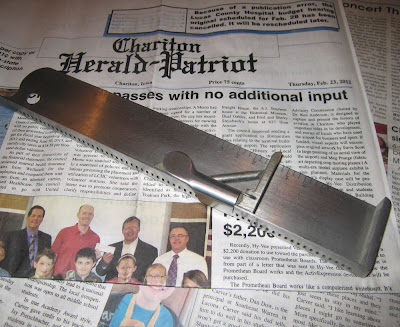Sifting through a small box at the museum yesterday, I came upon two extraordinary items --- one that we've been looking for for months, the other unexpected; both printed.
I've whined before about the sorry organizational state of the thousands of documents, scraps of paper, photographs and other paper artifacts that rest, for the most part out of sight, in Iowa's local history museums, including Lucas County's. This is no one's fault; volunteer-staffed institutions because of limited time to deal with high volume have been storing these items for years in the hope that sometime, someone would have time to deal with them.
If a paper item was accessioned individually, we know we've got it. When accessioned as batches, as in "50 miscellaneous photos," we don't really know what we've got. That's changing for all sorts of reasons, but the solution involves dealing methodically with a mountain of paper, still time-consuming.
Anyhow, the unexpected item was a single ediction of The Chariton Patriot from 1869. There just aren't any surviving Patriot editions from that year, due to fires and other disasters. Of so I'd thought. Now I know that there's at least one.
Because of the high rag content of the paper on which it was printed, the issue is in remarkably good shape --- still white, still pliable, only slightly torn along fold lines. It doesn't contain any remarkable news, but the fact it survived is remarkable in itself.
The other survivor is an 1865 edition of a New York newspaper reporting President Abraham Lincoln's assassination. That one, we knew we had --- somewhere. But it had been folded into small squares and placed by its original owner in a small open-ended document envelope with a printed cover suggesting that it contained something entirely different.
I didn't know what it was until I removed the envelope's contents and I still don't know much about it because it won't be unfolded until it can be dealt with properly. Unlike the 1869 Patriot, it appears to be serously deteriorated.
+++
The odd thing about vintage issues of newspapers is that they've become more desirable, primarily because 30 or more years ago when microfilm became widely available, depositories of old newspapers in many instances had their holdings filmed, then disposed of the originals.
In Iowa, the State Historical Society tried to subscribe for more than a century to every newspaper published in the state. These were collected, bound by year (or volume) and kept at the old Historical Society building (now Ola Babcock) in Des Moines.
Anyone who researched there back in the good old days remembers the drill --- walk into the newspaper room knowing which volume of which newspaper you wanted to examine; write it on a slip of paper and hand that to a staffer; sit down at a table with the bound volume when it arrived from the stacks; leaf through until you found what you wanted; note the item and page on another slip of paper; take both that and the bound volume to another staffer; and eventually receive a photocopy of what you wanted.
When microfilm came in, those bound volumes went out the door and most didn't fare well, although in a few cases repositories were found in the communities where the newspapers originated. In some cases, newspapers were cut apart, obituaries pasted in scrapbooks and everything else thrown away. And in many cases, volumes were burned to taken to the dump.
Even today, when asking about back issues of newspapers you'll hear, "not to worry --- they're on microfilm," which is not necessarily the case because the Historical Society's collection, although vast, was not complete and film from that collection remains the principal resource still available to researchers either on film or in a later digitalized (from microfilm) form. Heaven only knows what else is still tucked away in the store rooms of local newspaper offices.
+++
Of course I didn't have the camera at the museum yesterday, so the illustration here is my printer's composing stick, a souvenir from typography classes at the University of Iowa. Other than boilerplate, everything in that 1869 edition of The Patriot would have been set into type using a somewhat earlier version of this device.
Type was pulled letter by letter from a case and assembled line-by-line in one of these devices, then carefully secured between strips of lead or brass and transferred into the form from which the newspaper was printed and secured. It was a complicated and time-consuming process, which explains why in most instances --- until linotypes came along --- routine local news was shared in a few sentences rather than a few papagraphs.


No comments:
Post a Comment